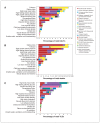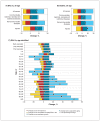Assessment of the burden of diseases and injuries attributable to risk factors in Canada from 1990 to 2016: an analysis of the Global Burden of Disease Study
- PMID: 30819694
- PMCID: PMC6397034
- DOI: 10.9778/cmajo.20180137
Assessment of the burden of diseases and injuries attributable to risk factors in Canada from 1990 to 2016: an analysis of the Global Burden of Disease Study
Abstract
Background: An understanding of the risk factors contributing to disease burden is critical for determining research priorities and informing national health policy. We aimed to identify the risk factor trends in Canada.
Methods: As part of the Global Burden of Disease (GBD) study (1990-2016), we conducted an analysis of country-level estimates for Canada to assess the burden of diseases and injuries attributable to risk factors. For both 1990 and 2016, metabolic, environmental and behavioural risk factors were ranked according to their contribution to disability-adjusted life years (healthy years of life lost), total deaths and years lived with disability.
Results: In 2016, the risk factors accounting for the largest percentage of disability-adjusted life years in Canada were (1) tobacco, (2) diet, (3) high body mass index, (4) high fasting plasma glucose, (5) high systolic blood pressure, (6) alcohol and drug use, (7) occupational risks, (8) high total cholesterol, (9) impaired kidney function and (10) air pollution. Risk factor rankings remained similar from 1990 to 2016 despite some substantial declines in burden, including a 47% (± 3%) decline in the age-standardized disability-adjusted life years rate attributable to tobacco since 1990. Risk factors with an increasing contribution to disability-adjusted life years rates from 1990 to 2016 included high body mass index, high fasting plasma glucose and alcohol and drug use.
Interpretation: Metabolic and behavioural risk factors, including modifiable factors such as tobacco use and diet, remain the leading risk factors contributing to the burden of diseases and injuries in Canada. This work identifies priorities and targets for reducing premature death and disability burden in Canada.
Copyright 2019, Joule Inc. or its licensors.
Conflict of interest statement
Competing interests: Aaron Drucker reports grants and personal fees from Sanofi and Regeneron for activities outside the work reported here. No other competing interests were declared.
Figures




Similar articles
-
Dissonant health transition in the states of Mexico, 1990-2013: a systematic analysis for the Global Burden of Disease Study 2013.Lancet. 2016 Nov 12;388(10058):2386-2402. doi: 10.1016/S0140-6736(16)31773-1. Epub 2016 Oct 5. Lancet. 2016. PMID: 27720260
-
Nations within a nation: variations in epidemiological transition across the states of India, 1990-2016 in the Global Burden of Disease Study.Lancet. 2017 Dec 2;390(10111):2437-2460. doi: 10.1016/S0140-6736(17)32804-0. Epub 2017 Nov 14. Lancet. 2017. PMID: 29150201 Free PMC article.
-
The burden of disease in Spain: Results from the Global Burden of Disease 2016.Med Clin (Barc). 2018 Sep 14;151(5):171-190. doi: 10.1016/j.medcli.2018.05.011. Epub 2018 Jul 20. Med Clin (Barc). 2018. PMID: 30037695 English, Spanish.
-
Overview.S Afr Med J. 2022 Sep 30;112(8b):556-570. doi: 10.7196/SAMJ.2022.v112i8b.16648. S Afr Med J. 2022. PMID: 36458357
-
The global burden of ischemic stroke: findings of the GBD 2010 study.Glob Heart. 2014 Mar;9(1):107-12. doi: 10.1016/j.gheart.2014.01.001. Glob Heart. 2014. PMID: 25432120 Review.
Cited by
-
The Child Health Protection Act: advocacy must continue.CMAJ. 2019 Sep 23;191(38):E1040-E1041. doi: 10.1503/cmaj.190857. CMAJ. 2019. PMID: 31548189 Free PMC article. No abstract available.
-
Trends in obesity across Canada from 2005 to 2018: a consecutive cross-sectional population-based study.CMAJ Open. 2022 May 24;10(2):E439-E449. doi: 10.9778/cmajo.20210205. Print 2022 Apr-Jun. CMAJ Open. 2022. PMID: 35609927 Free PMC article.
-
Food Addiction and Tobacco Use Disorder: Common Liability and Shared Mechanisms.Nutrients. 2020 Dec 15;12(12):3834. doi: 10.3390/nu12123834. Nutrients. 2020. PMID: 33334010 Free PMC article. Review.
-
Validation of a Case Definition to Identify Patients Diagnosed With Cardiovascular Disease in Canadian Primary Care Practices.CJC Open. 2023 Apr 22;5(7):567-576. doi: 10.1016/j.cjco.2023.04.003. eCollection 2023 Jul. CJC Open. 2023. PMID: 37496780 Free PMC article.
-
Building a House on Sand: How Tobacco Use Is Devouring Resources.Addict Health. 2023 Apr;15(2):128-135. doi: 10.34172/ahj.2023.1375. Epub 2023 Apr 29. Addict Health. 2023. PMID: 37560397 Free PMC article. Review.
References
-
- Smith JN. Epic measures: One doctor Seven billion patients. 1st ed. New York: HarperCollins; 2015.
-
- Mokdad AH, Forouzanfar MH, Daoud F, et al. Global burden of diseases, injuries, and risk factors for young people’s health during 1990–2013: a systematic analysis for the Global Burden of Disease Study 2013. Lancet. 2016;387:2383–401. - PubMed
LinkOut - more resources
Full Text Sources
Medical
Research Materials
